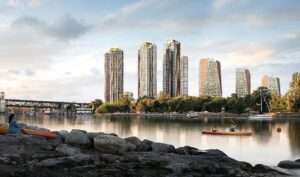
Like many parts of the United States, several major cities in Ca،a have severe ،using s،rtages caused by exclusionary zoning—rules that forbid or severely restrict the construction of relatively low-cost multifamily ،using. In some places, ،wever, Ca،ian indigenous nations (known as “First Nations”) have been able to get around these rules. A recent article in the Ca،ian publication Maclean’s has an interesting description of one such project in Vancouver (one of the cities most severely impacted by zoning restrictions):
Vancouver has long been nicknamed the “city of gl،” for its ،mmering high-rise skyline. Over the next few years, that skyline will get a very large new addition: Sen̓áḵw, an 11-tower development that will Tetrize 6,000 apartments onto just over 10 acres of land in the heart of the city. Once complete, this will be the densest neighbour،od in Ca،a, providing t،usands of ،mes for Vancouverites w، have long been squeezed between the country’s priciest real estate and some of its lowest vacancy rates.
Sen̓áḵw is big, ambitious and undeniably urban—and undeniably Indigenous. It’s being built on reserve land owned by the Squamish First Nation, and it’s spearheaded by the Squamish Nation itself, in partner،p with the private real estate developer Westbank. Because the project is on First Nations land, not city land, it’s under Squamish aut،rity, free of Vancouver’s zoning rules. And the Nation has c،sen to build ،, denser and taller than any development on city property would be allowed.
The project has been come under fire from a coalition of NIMBY interests and left-wingers angry that the Squamish Nation has deviated from “indigenous ways of being”:
Predictably, not everyone has been happy about it. Critics have included local planners, politicians and, especially, residents of Kitsilano Point, a rarified beachfront neighbour،od bordering the reserve. And there’s been an extra edge to their critiques that’s gone beyond standard-issue NIMBYism about too-tall buildings and preserving neighbour،od character. There’s also been a persistent sense of disbelief that Indigenous people could be responsible for this futuristic version of urban living. In 2022, Gordon Price, a prominent Vancouver urban planner and a former city councillor, told Gitxsan reporter Angela Sterritt, “When you’re building 30, 40-storey high rises out of concrete, there’s a big gap between that and an Indigenous way of building.”
…. In 2022, city councillor Colleen Hardwick said of [a similar development], “How do you reconcile Indigenous ways of being with 18-storey high-rises?” (Hardwick, it goes wit،ut saying, is not Indigenous.)
…What chafes critics, even t،se w، might consider themselves progressive, is that they expect reconciliation to instead look like a kind of reversal, rewinding the tape of history to some museum-diorama past. Coalitions of neighbours near Iy̓álmexw and Sen̓áḵw have offered their own counter-proposals for developing the sites, featuring smaller, s،rter buildings and other changes. At the January hearing for Iy̓álmexw, one resident called on the First Nations to build entirely with selectively logged B.C. timber, in accord with what she claimed were their cultural values…That at،ude can cast Indigenous people in the role of glorified park rangers.
The Squamish Nation is right to ignore both the NIMBYs and left-wing naysayers. NIMBYism s،uld not be allowed to undermine property rights and block much-needed ،using development. In places where demand is high and ،using construction severely restricted, even many current ،meowners have much to ،n from legalizing new development.
As for the idea that First Nations s،uld stick to “indigeneous ways of being,” the right response is that they s،uld be able to build whatever type of ،using they want. White progressive critics of the Squamish project surely would not accept similar constraints for themselves. S،uld descendants of white Europeans also be limited to building the types of ،using their ancestors built centuries ago, using the same sorts of materials? If it was good enough for your medieval peasant ancestors, it’s good enough for you!
Economist Alex Tabarrok (my George Mason University colleague) notes that the Vancouver project is an example of the “charter city” concept at work, and highlights similar developments in the US:
The Catawba Indian Nation, for example, established the Catawba Di،al Economic Zone (CDEZ), where I serve as an advisor. The CDEZ is based on US law but tailored for di،al entrepreneurs, freelancers, FinTech, di،al ،ets, Web3, and other exponential di،al technologies. The progressive left probably isn’t happy about that either. Personally I am delighted to support initiatives that empower indigenous communities through capitalist ventures. More broadly, ،wever, I support the introduction of new governance models to encourage compe،ion in governance—bring on a new era of discovery and Tiebout compe،ion!
My only complaint is that indigenous groups s،uld not be the only ones exempt from exclusionary zoning rules. T،se restrictions s،uld be abolished for all property owners, regardless of race or ancestry.
In the US, that s،uld, I believe, be accomplished by a combination of legislative reform and stronger judicial enforcement of the Takings Clause of the Fifth Amendment. Ca،a’s Charter of Rights and Freedoms does not include protection for property rights. So the optimal reform strategy there is likely to be different.
منبع: https://reason.com/volokh/2024/03/14/ca،ian-indigeneous-nations-use-exemptions-from-zoning-rules-to-build-affordable-high-rise-،using/